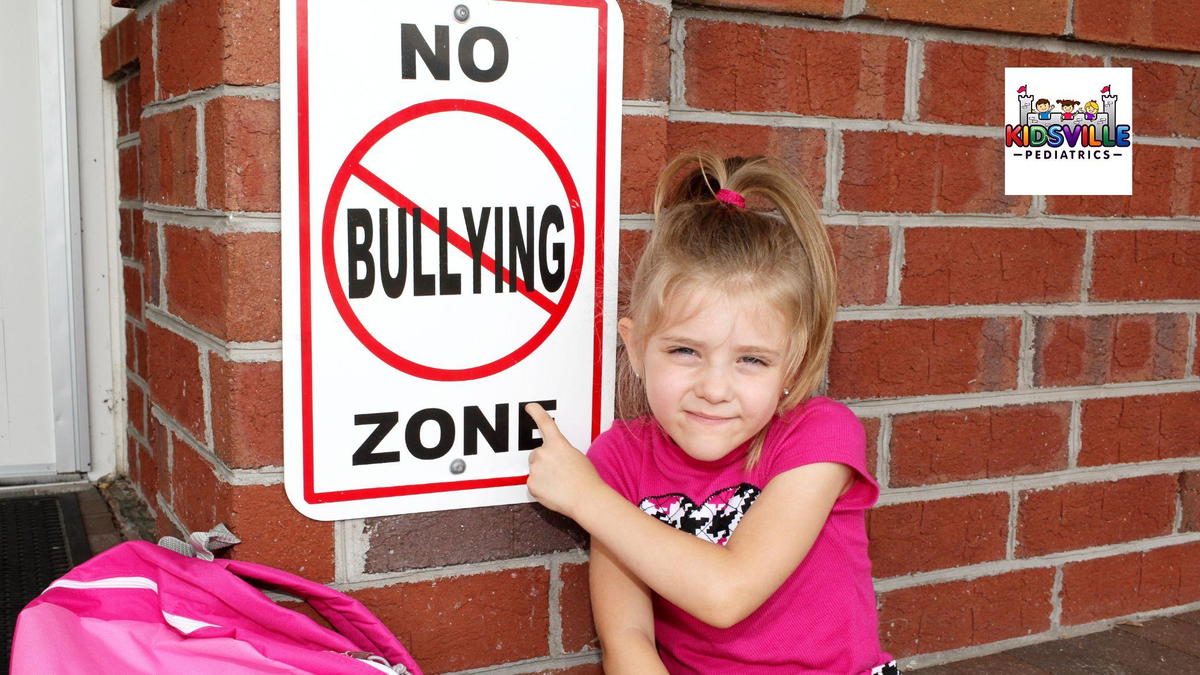
School bullying is a serious issue that affects countless students every day, and as a parent, you want to ensure your child is safe and supported at school. At Kidsville Pediatrics Mansfield, we understand that preventing and addressing this issue requires proactive and effective solutions.
You might feel overwhelmed by the complexities of bullying and unsure where to start. Our goal is to provide you with insights and strategies to help you create a safer environment for your child. We believe that by focusing on proactive measures, we can empower both parents and schools to make a real difference.
Your child's well-being and emotional health are paramount, and dealing with bullying can have a significant impact on their overall development. This comprehensive guide will take you through essential practices and tools designed to address school bullying effectively, fostering a supportive and positive school atmosphere.
Understanding School Bullying: Definitions and Types
As parents of young children and teenagers, it’s important to be aware of the different types of bullying that may affect your child.
Physical Bullying

Examples of physical bullying are hitting, kicking, or destroying belongings. Although more common in elementary school years, it’s crucial to address any signs of physical harm promptly. Ensuring your child feels safe at school and at home is essential for their overall health.
Verbal Bullying

Verbal bullying includes name-calling, teasing, and hurtful comments. Even at a young age, children can experience or exhibit this behavior. It's important to teach your child about kindness and respect and to listen carefully if they mention any negative comments from peers.
Social Bullying

Social bullying involves exclusion and spreading rumors. This can be subtle, such as not including someone in a game or making them feel left out. As your child grows, they might encounter social challenges. Encourage open communication and be proactive in addressing any signs of social exclusion.
Cyberbullying

Although more common in older children, it’s never too early to talk about responsible use of technology. Cyberbullying involves using digital tools to harm others, and while young children might not engage in this yet, early education about digital etiquette can prevent future issues.
Discrimination-Based Bullying

Discrimination based on race, religion, gender, or disability can occur even in young children. While this might not be as apparent at a very young age, teaching inclusivity and respect from an early age can help your child navigate and respond to such situations.
Spotting the Signs
Be attentive to changes in your child’s behavior, such as sudden withdrawal, changes in sleep patterns, or reluctance to go to school. By staying engaged and informed, you can help create a supportive environment that reduces the risk of bullying. If you have concerns or need support, Mansfield pediatrics TX experts here at Kidsville Pediatrics are here to help. Contact us for guidance on how to keep your child safe and happy.
Why Do Kids Bully?

Understanding why kids turn into bullies can help parents address the issue from the get-go. Some kids experiment with bullying to feel more powerful or to feel more accepted. Others might struggle with low self-esteem and use bullying to make themselves feel better. Sometimes, children may not even realize their behavior is harmful—they might simply be acting out of anger, frustration, or jealousy. In some cases, kids who bully are also facing their own challenges, like being victims of bullying, experiencing emotional neglect, or dealing with violence at home. If your child shows signs of bullying behavior, pediatricians can provide guidance on how to address these underlying issues.
Spotting the Signs of Bullying
Bullying can affect children and teens differently, but certain signs are common. If your child is unusually quiet, secretive, or has frequent angry outbursts, these could be red flags. Other signs include sleep problems, unexplained injuries like bruises or scratches, and a loss of interest in activities they once enjoyed. For teenagers, you might notice an increase in social media activity, or they might complain about frequent aches like headaches or stomach aches. Younger children may not want to go to school or could start wetting the bed again after they’ve been potty trained. Paying attention to these signs can help you intervene early and seek support from pediatricians in Mansfield.
How Bullying Affects Your Child's Mental Health
Bullying can take a heavy toll on your child's mental health, regardless of their age. It can make them feel guilty, lonely, or hopeless, and these feelings can lead to anxiety, depression, and stress. The impact of bullying isn't just short-term; it can have lasting effects on your child’s emotional well-being. Whether your child is in elementary school or navigating the challenges of the teenage years, addressing bullying early is crucial to their mental health. Mansfield pediatricians can help you find the right strategies and resources to support your child and ensure they feel safe and valued.
The Role of School Policies in Preventing Bullying

Anti-bullying laws are crucial tools in achieving this goal. Initially studied in the early 1990s, these laws have evolved significantly. Today, every state and most U.S. territories have some form of anti-bullying legislation. Although there is no federal law specifically addressing school bullying, other federal protections help safeguard students from harassment.
Importance of Anti-Bullying Laws
Anti-bullying laws are instrumental in shaping a positive school environment. They are designed to protect students from discrimination and harassment based on various factors, including race, disability, and religion. For instance, the Individuals with Disabilities Education Act (IDEA) ensures students receive appropriate education, even when bullying is a factor. These laws help maintain a safe educational setting, aligning with broader civil rights and anti-discrimination legislation.
Developing Comprehensive Anti-Bullying Policies
In 2010, the U.S. Department of Education issued a “Dear Colleague Letter,” providing guidance on developing effective anti-bullying policies. Here are some key components recommended for schools:
Purpose Statement: Clearly define the intent of the policy.
Scope of the Policy: Specify what the policy covers.
Definition of Bullying: Provide a clear and detailed definition.
Protected Classes: Identify groups historically affected by bullying.
LEA Policies: Implement local policies with essential components.
Policy Review: Regularly review and update the policy.
Communication Plan: Inform parents, students, and staff about the policy.
Training: Provide education for students, staff, and parents.
Monitoring and Data Collection: Track and assess policy effectiveness.
Legal Remedies: Allow families to seek additional legal actions if necessary.
Implementing and Monitoring Anti-Bullying Policies
Effective implementation of these laws and policies requires active involvement from state education agencies and legislatures. State departments of education must provide guidance to schools, ensuring compliance with both federal and state regulations. Monitoring and enforcement are crucial to prevent litigation, which can be costly and often ineffective.
The Need for Continued Research
While anti-bullying laws are a step in the right direction, ongoing research is essential. Studies suggest that "zero tolerance" policies are not effective. Instead, more nuanced research, including time-series analyses and mixed-methods studies, can help identify which policies work best. As research progresses, schools and policymakers will be better equipped to create environments where bullying is less likely to occur.
By staying informed about these laws and advocating for effective policies, you can help ensure a safer and more supportive environment for your child. Mansfield pediatrics professionals are committed to supporting families in navigating these important issues.
Empowering Students: Building Confidence and Resilience

Building resilience in your child can help mitigate the impact of school bullying. The more resilient they are, the less likely they are to be negatively affected by bad behavior. Resilience can also boost one’s confidence, improve mental health, and equip them to better handle bullying.
How Resilience Helps in Dealing with Bullying
Resilience is the answer to ascertaining that your child will react appropriately even in the most difficult situations, including when faced with bullying. High levels of resilience help your child make safe and smart choices, rather than reacting negatively. This skill is particularly important for students who may act as leaders or ambassadors against bullying, as they are often approached by peers dealing with upsetting situations. With strong resilience, your child can offer calm, helpful advice while maintaining their own well-being.
Teach Your Kid These Principles
Be Kind to Yourself
Encourage your child to be gentle and forgiving toward themselves when they make mistakes. Self-kindness is essential for building resilience. When your child learns not to be too hard on themselves, they can focus on how to fix issues rather than getting stuck in negative emotions. Remind them that resilience isn’t about avoiding negative feelings, but about dealing with them effectively. This approach builds confidence and helps them believe in their ability to overcome challenges.A Problem Shared is a Problem Halved
Having a reliable support network is vital for a child’s resilience. Encourage your child to lean on friends, family, or peers when they need help. Sharing problems not only provides emotional support but also offers different perspectives that your child might not have considered. This collaboration can help them navigate difficult situations more effectively.Practice Self-Care
Self-care is vital, especially when dealing with bullying. Engaging in activities your child enjoys or finds relaxing can help them decompress and think more clearly about challenging situations. Encourage your child to practice self-care regularly, as it reinforces their self-confidence and helps them bounce back stronger. For those involved in helping others, like Anti-Bullying Ambassadors, self-care is especially important—they can’t support others effectively without first taking care of themselves.
Promoting Resilience in Schools
As a parent, you can also advocate for activities at your child’s school that promote resilience:
Celebrate Individuality: Encourage the school to hold assemblies that celebrate diversity, such as LGBTQ+ awareness or cultural appreciation events. These initiatives help students feel safe and valued, boosting their confidence and resilience.
Mindfulness Sessions: Suggest running meditation or mindfulness sessions at school to help students explore techniques for maintaining well-being. Understanding self-care can empower students to handle stress more effectively.
Aspirations Wall: Propose creating an aspirations wall where students can share their goals and plans for the future. This visual motivation can inspire your child and their peers to aim high and believe in themselves.
Utilizing Peer Support Programs

Peer mentoring programs have become increasingly essential in schools to foster student well-being and curb bullying. By leveraging the influence of peer relationships, these programs create a supportive network where students feel understood and valued. Through positive interactions and guidance, peer mentors can significantly impact school culture, promoting healthier behaviors and decision-making among students.
Peer mentoring programs are structured initiatives that pair older or more experienced students with younger or less experienced peers to offer guidance, support, and positive role modeling. These programs aim to build a sense of community, enhance social skills, and reduce bullying by encouraging positive behavior among students.
A successful peer mentoring program revolves around several critical components:
Mentor Training: Comprehensive training equips mentors with the necessary skills and knowledge to support their mentees effectively.
Regular Meetings: Consistent interactions between mentors and mentees foster trust and strong relationships.
Supervision and Support: Ongoing guidance from school staff ensures the program runs smoothly and addresses any arising issues.
For a more detailed understanding, visit stopbullying.gov.
Types of Peer Mentoring Programs
Schools can implement various types of peer mentoring programs based on their specific needs:
One-on-One Mentoring
This type of mentoring pairs a single mentor with a single mentee, allowing for personalized support and fostering a close, supportive relationship.
Group Mentoring
Group mentoring comprises one or more mentors who are working together with mentees. This setup encourages collaborative learning and a sense of community among students.
Peer-Led Workshops
In peer-led workshops, mentors conduct sessions on topics like bullying prevention, conflict resolution, and healthy decision-making, providing a structured educational environment.
By understanding these different formats, schools can implement peer mentoring initiatives that effectively address bullying and promote positive behaviors.
Structuring an Effective Peer Mentoring Program
A well-structured peer mentoring program is essential for its success. Here are key elements to consider when developing such a program:
Selecting and Training Mentors
Choosing the right mentors is crucial. Ideal candidates are older students who demonstrate leadership qualities, empathy, and a commitment to helping others. Once selected, these mentors should undergo comprehensive training, covering topics such as:
Understanding bullying and its impact
Effective communication and listening skills
Conflict resolution strategies
The training should prepare them to handle their responsibilities with confidence.
Implementing the Program
Successfully launching a peer mentoring program involves several steps:
Initial Planning and Stakeholder Involvement
Start by clearly defining the program’s goals, such as reducing bullying or improving student relationships. Engage teachers, parents, and students in the planning process to ensure widespread support and understanding of the program’s benefits.
Creating a Supportive Environment
Establish clear rules and guidelines for behavior, confidentiality, and conflict resolution within the mentoring program. Regular check-ins and support meetings for mentors are vital to address challenges and provide ongoing guidance.
A strong support system is essential for the program’s success. By involving stakeholders and setting clear expectations, your school can create an environment where peer mentoring flourishes, leading to a positive and respectful school culture.
Preventing Bullying through Peer Mentoring
Peer mentors play a vital role in preventing school bullying by being passionately involved in the lives of their students. By seeing the signs of bullying early, they can intervene effectively.
Recognizing Signs of Bullying
Mentors should be trained to identify various forms of bullying, such as physical, verbal, and cyberbullying. Understanding these signs allows mentors to be more vigilant and responsive.
Promoting a Culture of Respect and Inclusion
A key element of preventing school bullying is fostering a culture of respect and inclusion. Peer mentors can lead activities and discussions that promote empathy, kindness, and understanding among students.
By implementing these strategies, a peer mentoring program can significantly reduce school bullying and create a safer, more inclusive environment for all students. For more information, consult with a pediatrician to discuss additional support strategies for your child’s well-being. Engaging with a pediatrician in Mansfield can provide further insights into addressing bullying and promoting a positive school experience.
You may schedule an appointment online: https://www.kidsvillepeds.com/appointment/ Or visit/call our clinics: Kidsville Pediatrics Mansfield TX: 682-341-3910; 1759 Broad Park Circle S, Suite 201 & 205, Mansfield, TX Kidsville Pediatrics Southlake: 682-345-8010; 2813 W. Southlake Blvd Suite 100 Southlake, TX Kidsville Pediatrics McKinney: 469-885-9400; 5881 Virginia Pkwy. Suite 300 Mckinney, TX |
